All posts by Andrea Grant
About Andrea Grant
Andrea Grant is a Children's Services Specialist. View all posts by Andrea Grant →
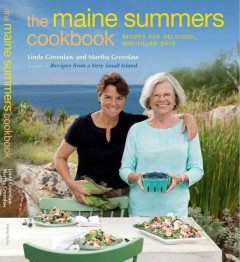
Bibliobites in June: A Maine Event
Summer was knocking on the door as we met at the end of June to discuss The Maine Summers Cookbook by Linda Greenlaw and Martha Greenlaw. Linda, a swordfish-boat captain made famous in Sebastian Junger’s The Perfect Storm, is an accomplished author in her own right, with mysteries, memoirs, nonfiction, and cookbooks to her credit. Logically enough, this title focuses on what we think of as classic New England summer fare– anything grilled; lots of seafood; salads and veggies fresh from the garden; and tried-and-true desserts like pie and ice cream. Ms. Greenlaw’s affection for Maine and for Isle au Haut (her family’s summer home) in particular is evident throughout the book, as is her passion for locally grown and produced food. The stories in many of the recipes’ headnotes give the reader a real feel for the island community, and the scenic photography provides an (almost!) “you are there” experience.
But with a cookbook, it’s really all about the recipes, and we made plenty! A thumbs-up was given to the Maine shrimp gazpacho; and the Moxie Island baked steak was “tasty.” The grilled turkey burgers with tomato-mango chutney were good, though nothing out of the ordinary, and the chutney was liquidy and refused to stay on the burger. The sweet corn salsa was a delicious, less messy accompaniment. Many recipes utilized shrimp: one member loved both the baked shrimp with garlic-basil butter and Patty’s buttery stuffed shrimp. Maine shrimp risotto was good, but even better after mellowing for a day or two in the fridge. Two people tried the tomato, caramelized onion, and brie galette, which had a delicious combination of flavors. The dough for the galette is piecrust, which seemed too rich with the cheese– pizza dough might make a better base. The eggplant fritters were a bit problematic– the patties were too wet despite roasting and then draining the eggplant. But the chunky chickpea salsa was a winner.
As for baked goods and desserts, the ginger-bran blueberry muffins were “excellent!”, and the old-fashioned peanut butter cookies were enjoyed by all at the meeting (thank you, Linda). The cinnamon-blueberry ice cream sounded tantalizing, but required 12 egg yolks for the recipe, which seemed a bit excessive; so no one actually made it!
Several people tried side dishes; among the favorites were the rosemary-balsamic roasted red potatoes; roasted new potato salad (“loved the tarragon!”); corn pudding with fresh basil; salad of tomato, feta, and basil; oven-roasted summer squash; and baby peas with mustard, horseradish, and butter.
The overall consensus was that the book fell short of awesomeness. People mostly liked what they tried, but they weren’t jumping up and down about it. Maybe we weren’t quite in summer cooking mode yet? There were some complaints about incomplete or incorrect instructions for some of the recipes, or ingredient proportions (see eggplant fritters above!). This led to speculation that the authors did not thoroughly test the recipes, or possibly didn’t even test them themselves. And editing could certainly have been better: for instance, the coconut panko cod recipe has backwards instructions for breading the fish. Some didn’t care for this title’s memoir-within-a-cookbook format, which seems to have become so popular; that is, cookbooks which have extensive stories and/or travelogues along with their recipes.But while most of us were pretty lukewarm about this title, one person loved it so much she was planning to buy it. She thought it was the perfect summer cookbook– so for her it was a welcome discovery. So when it came down to a vote, our likes and dislikes perfectly averaged themselves out, to leave us with a rating of: ![]()
![]()
![]()
Bibliobites will not meet in July and August, but we hope you’ll have lots of summer cooking adventures! Email us photos of your successes and flops, and we’ll publish them in a future post. Our next meeting will be on Friday September 30 at 11 AM in the Fireplace Room, title TBA.

Delicious Meets Healthy! – Bibliobites in May
Do I eat “healthy,” or do I choose what I really want? Do I have that yummy dessert with a million calories, or that boring old fruit salad? Pepperoni pizza for lunch, or a virtuous bowl of greens with oil-free dressing? Burgers and beer at a barbecue, or grilled chicken breast and seltzer water? These and countless other choices plainly illustrate the yin and yang of American eating– the idea that, if it tastes good it’s not good for you, and if it’s good for you, it’s boring and flavorless. This month’s title, Ellie Krieger’s The Food You Crave: Luscious Recipes for a Healthy Life aims to sweep away that uncomfortable dichotomy with recipes both healthy and delicious. Does she succeed? Let’s get straight to it:
First, people enjoyed the design of the book; its larger format meant most recipes could fit on one page, and there were plenty of gorgeous photos. And it stayed open by itself, always a big plus. The contents run the gamut from appetizers to desserts, and Ms. Krieger provides complete nutrition information (she is a registered dietitian, after all). One downside I discovered while writing this post: the index is awful! Many recipes are inexplicably not listed by name, and other oddities abound.
As always, though, the recipes tell the tale, and the takeaway seemed to be that this was an eminently approachable book: more than 30 recipes were tested, and a few sounded intriguing enough that multiple people made them. Since life is uncertain, let’s eat dessert first: the mocha cake with mocha cream cheese frosting was personally tested by group members, and was praised for its deep chocolate taste. The triple chocolate cookies also had plenty of true chocolate flavor and were easy to make. In the breakfast department, the nutty granola was a huge hit, disappearing rapidly; the scrumptious scramble was….scrumptious, and the apple-pecan muffins were “fruity and not too sweet– delicious!”
But for most people, the main dishes were the big attraction: recipes people enjoyed included the macaroni and four cheeses (“the first day I thought the squash flavor was too much, but the next day it was better”), sloppy joes (“good but too much red pepper”), confetti chili, (“delicious! But next time I’ll use less corn”), Greek-style stuffed peppers (“really good, and Mr. Fussy liked them, too!”), steak tacos with cucumber-avocado salsa, baked shrimp with tomatoes and feta, teriyaki chicken thighs (“good and sticky”), peppercorn pork with wine sauce (“delicious and so easy”), fettucine Bolognese, balsamic chicken with baby spinach and couscous (“best thing I made; very quick and very tasty;” vs., “I didn’t like the spinach in it, and it wasn’t quick”), and salmon cakes with ginger-sesame sauce (“the cakes were just OK, but the sauce is delicious!”).
For some sides to go with those main dishes, how about honey-roasted sweet potatoes, dirty broccoli, roasted nutmeg cauliflower, zucchini Parmesan crisps (“very good and super-easy…family gobbled them down!”), and cornmeal-crusted ratatouille tart (“flavor was good…needed more veggies, crust was too hard”). Several people raved about the lemon chicken soup with orzo; to go with it you could try sweet and spicy grilled cheese sandwiches. If it’s too hot to cook, salads like grilled Thai beef salad (“so many great flavors!”), savory Chinese chicken salad (“fresh and crunchy…I really liked the fruit in it”), or chickpea and spinach salad with cumin dressing (“easy to make, and good”) can get you out of the kitchen in a hurry.
In general, the book was praised for having lots of flavorful (dare I say crave-able?) recipes using everyday ingredients. We appreciated that most recipes were fairly quick, and a few were amazingly speedy. Several people weren’t ready to return the book, as there were more recipes they were eager to try. A few group members decided they wanted to buy the book– what higher praise could there be? There were a few complaints, though: some recipes used small quantities of ingredients that you might have trouble using up; for example, one recipe calls for 1/4 cup evaporated milk, another uses 3 sheets of phyllo dough (after you’ve defrosted the entire box to remove what you need!). A few people wished for menu suggestions– ideas on what to serve with what.
So does Ellie Krieger deliver on her promise of good and good for you? In the opinion of the group, definitely yes! Overall verdict: ![]()
![]()
![]()
![]()
Our next meeting will be on Friday, June 24 at 11 AM in the Fireplace Room. Our title this month is The Maine Summers Cookbook: Recipes for Delicious, Sun-Filled Days by Linda Greenlaw and Martha Greenlaw. Copies are available at the main desk. Our June meeting will also feature a cookbook swap! Bring one or more titles that you no longer want, and take home a “new” one to try out. Any extra books will be donated to the Friends book sale. See you then!
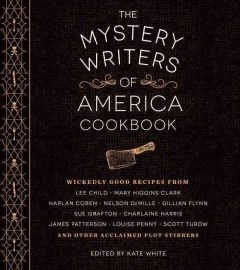
Bibliobites in April: Writers in the Kitchen
It’s no mystery that most of our Bibliobites members enjoy cooking; and many of us enjoy a good mystery novel as well. And it seems that, at least in the literary world, murder and mayhem often go hand in hand with culinary exploits of one sort or another. There are plenty of suspenseful books that feature a caterer, or a character who loves/hates to cook, or a detective who is known for his or her idiosyncratic eating habits (peanut butter and pickle sandwiches, anyone? See p. 67!). This month we read and cooked from The Mystery Writers of America Cookbook and it afforded us a unique opportunity to merge writers, their fictional characters, and some new recipes all at the same time.
First, the book itself: most of us liked the size of the book, with pages large enough that most recipes were only on one page. There were plenty of photos, too, though there was some doubt as to whether the pictures were of the actual recipes, as some didn’t seem to quite match up. Everyone appreciated that the book stayed open when using a particular recipe, and didn’t have that annoying habit of flopping closed just when you have messy hands.
For many, the best attribute of the book was the copious headnotes, which gave us some insight into the author’s thoughts about cooking in general, or the particular recipe, or what their character would have thought about it. It was fun to read these descriptions, which were by turns humorous, heartfelt, or surprising. It made for an enjoyable read, even if you didn’t want to cook anything, which was one of the reasons we thought this book would make a good gift. In addition, most of the recipes were on the quick side, and used ingredients that were easy to find. The book would also provide the mystery lover with a long list of books and authors to check out; many of us now have much longer reading lists!
But down to the nitty-gritty: what about the actual recipes? In general, people liked what they tried; among the favorites were the avgolemono soup (“loved it– healthy and easy!”), the chicken artichoke tarragon soup (“easy, flavorful, creamy without using cream, a keeper!”), Grand-mere Marie’s root vegetable vichyssoise (“really liked it, lends itself to ingredient substitution, will definitely make again!”). Also, the Italian chicken (“easy and flavorful”), spicy beans (“very good protein-centric non-meat meal”), spicy joes (“liked it very much, Greek and Turkish flavors– would probably be even better with lamb”), caramelized clay pot fish (“really delicious– quick and easy, and you don’t need a clay pot!”), chicken enchiladas (“as long as you don’t mind using a can of cream of chicken soup; good for a crowd”), shrimp scampi (“I had a great time with this recipe– it looked just like the photo and tasted great!”) Madame Benoit’s tourtiere (“so delicious– everyone loved it!”). A few people tried baking: the whole wheat wild blueberry lemon pecan muffins got a big thumbs-up; the killer chocolate cake was a winner (sans icing, which was “grainy”), and the Latvian solstice bars, which we got to sample at our meeting. These were “easy to make– very rich– the edges burned easily from all the sugar.”
On the negative side, Kathy’s Coke roast was “tender, but not very flavorful”; the spicy crock pot pork was “a little dry, and we didn’t care much for the flavor,” though another tester enjoyed it and didn’t feel it was dry. Neither thought it was terribly spicy! The world’s best red sauce wasn’t (“it was OK, a bit watery– wrong tomatoes?”); and the crab cakes had a “decent” taste but didn’t hold together well. (Others who love crab cakes suggested adding Old Bay seasoning, and refrigerating the mix before shaping the cakes to help them hold together better).
![]()
![]()
![]()
We instituted a rating system at our meeting, a scale of 1-5 chef hats, with 5 being the best. We all voted, and the average came out to 3.3; most members gave the book a 3 or a 4; no one awarded a 5. So, good but not great. Maybe those mystery writers should stick to writing!
Speaking of authors, a few cooking-related titles were recommended by group members. They included: Erica Bauermeister’s novel School of Essential Ingredients and Yes, Chef by Marcus Samuelsson. Check them out!
During our discussion, someone asked what was a good place to buy fresh fish. There seemed to be plenty of options; those who bought fish at Market Basket and Hannaford were quite satisfied with the quality. A bit further afield, Wegman’s and Whole Foods were praised, as was the frozen fish (especially the scallops) at Trader Joe’s. I put in my plug for Cape Ann Fresh Catch, which is a fish CSA that delivers day-boat fish from Gloucester to Jones Farm on Thursdays. Another mentioned the Chelmsford farmers’ market, which some weeks has a fish vendor. Living so close to the ocean, it seems we have lots of good choices!
Our next meeting will be Friday, May 27 at 11 AM in the Fireplace Room. Our title this month is The Food You Crave: Luscious Recipes For a Healthy Life by Ellie Krieger. Copies are available at the main desk. Happy cooking!
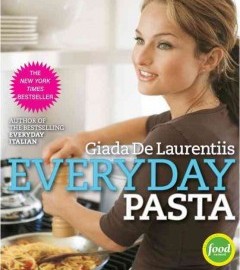
Bibliobites in March: Pasta, Per Favore!
Apparently, Italians didn’t invent pasta, but it could be argued that they’ve perfected it. It’s one of the cornerstones of their cuisine, eaten at almost every meal and with an infinite number of sauces and/or accompaniments. Americans, despite their flirtation with low-carb eating, have embraced pasta; it’s quick and easy to make, readily available and inexpensive, and can be as plain or as fancy as you want. At the recent meeting of CPL’s Bibliobites culinary book group, our two chosen titles explored pasta territory both familiar and unexpected.
The book most people experimented with was Giada DeLaurentiis’ Everyday Pasta. Amazingly, no two group members made the same recipe– good work, everyone! This variety made for a lively discussion. Recipes that were tried and that received a thumbs-up were: the tagliatelle with short-rib ragu (“very good!”), Roman-style fettucini with chicken (“easy to make….tender and delicious”), turkey artichoke stuffed shells (“delicious– a different way to prepare stuffed shells”), chicken piccata with (gluten-free) angel hair pasta (“the chicken was great but I learned you can’t reheat rice pasta– the texture suffers”), and the eggplant mezzaluna ravioli, made with wonton wrappers. This last was even a hit with “Mr. Fussy,” who hates eggplant but didn’t realize that was what he was eating. Reportedly he enjoyed every bite!
In the “OK but I probably wouldn’t bother with it again” category were the saffron with orzo and shrimp (“it didn’t have that much flavor”), capellini with tomatoes and peas (“nothing special”), the baked pastina casserole (“it needed something….garlic? wine?”), rigatoni with sausage, peppers, and onions (“good for a crowd but nothing outstanding”), and creamy pumpkin lasagna rolls, which were complicated to assemble and were “good but not worth the effort.”
On the negative side was the popover recipe (“it stuck to my non-stick pan, even though I used cooking spray!”), and the pasta and ceci soup (“easy to make but too salty”). The general feeling seemed to be that the book was good, but not terribly inventive. To be fair the book is called Everyday Pasta, and so probably isn’t designed to be cutting edge. We appreciated that most of the recipes were fairly quick and easy to make, and most used ingredients that are available in any supermarket.
However, if you want to try something a little more esoteric, look no further than our second title this month: Pasta Modern by Francine Segan. This book showcases modern twists on traditional recipes and/or recipes using less-familiar ingredients and combinations. For instance, soup in a sack involved making a dough of semolina, eggs, and chopped ham, which you then formed into a cylinder and enclosed in parchment paper. This “sack” was then simmered in broth. When cooked, it was diced and served in the broth. Different, and “really, really good!” Duck Venetian style was a sauce made of ground duck served over pasta. While the sauce didn’t seem to hold together all that well, the duck flavor was “different and delicious.” This recipe is pretty tough on the budget, though– duck breast is $14.99/lb! Zucchini-glazed pasta used a common ingredient in a new way: zucchini is grated, salted, and the squeezed juices are used as part of the pasta-cooking liquid. The grated zucchini is added raw or sauteed at the end: “very tasty!” Might come in handy during the summer glut of zucchini. Pumpkin carbonara sounded good: roasted squash and onions combined with an eggy sauce. But the sauce was nearly nonexistent, so it was basically a plate of pasta with roasted veggies– good but not what the recipe promised.
This title had plenty of tempting photographs, and a beautiful two-page display of many of the less-familiar pasta shapes– helpful when trying to find substitutes. Certainly this book is not an “everyday” one, but if you’re looking to expand your pasta repertoire and try something unique, this is a good book to check out.
For next month, we’ll be teaming up with our One Book Chelmsford community-wide reading program and doing our part to “Keep Chelmsford in Suspense.”
The Mystery Writers of America Cookbook features recipes contributed by leading mystery and suspense writers. From appetizers to desserts, these writers have tried it all; and we hope you will, too! Join us at our next meeting in the Fireplace Room on Friday, April 29 at 11 AM.

Bibliobites in February: Bake, Boil, Simmer, Stew, Stir……
……and enjoy! This month, instead of focusing on a specific title, we all participated in a “cooking challenge.” The idea was to make something you’d never tried before, either because it was too time-consuming, too intimidating, or too unfamiliar. Everyone seemed to enjoy their adventures in the kitchen and it was fun to hear about so many different experiences.
We discovered as we talked that one obstacle to trying certain challenges is the amount of time involved. Several members had to set aside almost a full day to complete their chosen recipe! One member made fish stock from Paul Prudhommes’s Fork in the Road, a book that focuses on healthier versions of many classic New Orleans dishes. The stock took 4-5 hours to make, but was “rich and delicious.” And while it’s true that making stock isn’t all hands-on, you do have to be in the house to periodically check on it.
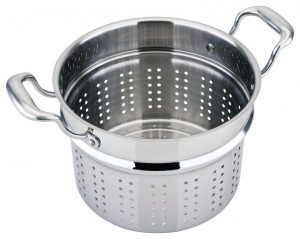 One person did have a great tip for making stock, though– use a pasta pot with a colander insert. When your stock is done, simply lift out the insert and all the bones and veggies will come out with it. Easier than lifting a heavy stockpot and pouring the boiling liquid through a strainer. Genius!!
One person did have a great tip for making stock, though– use a pasta pot with a colander insert. When your stock is done, simply lift out the insert and all the bones and veggies will come out with it. Easier than lifting a heavy stockpot and pouring the boiling liquid through a strainer. Genius!!
Another all-day affair was a classic pot roast from an America’s Test Kitchen recipe. You had to take the meat out of the fridge an hour before beginning; actual cooking time was 3-4 hours; then you needed a bit more time to make a sauce for the meat. Again, much of this time is hands-off– and the results were excellent. In a nod to the wordiness of ATK recipes, someone joked that it probably took 5 hours just to read the recipe!
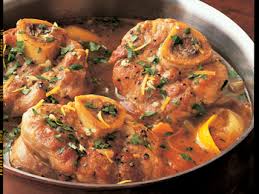
Continuing the simmering theme, one person made osso buco, a dish she’d been wanting to try for some time but hadn’t because…..it’s very time-consuming! She used a recipe from the Boston Globe that calls for veal shanks, a pricey ingredient that can be difficult to find. Meat Again in Billerica has them, and according to Wegman’s website, this is an item they carry as well. There was a happy ending after the hours of braising; the osso buco was a big hit with everyone in the family, even “Mr. Fussy”!
One member decided to try the roast chicken from Julia Child’s classic, Mastering the Art of French Cooking. The recipe requires focused attention on the task at hand, because you must baste the chicken every 5 minutes. This is not an exaggeration! But the chicken was “shockingly good.” To go with it she made Julia’s suggestion: ratatouille, which also had a very involved preparation; but it was “the best I’ve ever tasted!” So, a lot of effort but a rewarding result, which seems to be a theme here. If you want to see Julia make that roast chicken herself, watch this fun video!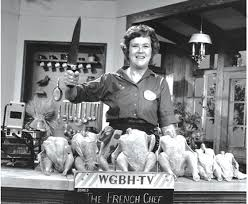 Also in the “high effort” category, I decided to try making tortellini. This is something my grandmother made, completely by hand, on a regular basis while I was growing up. While making the filling and the dough were fairly simple (and I had machines to help me!), rolling the dough and filling and shaping the tortellini took several hours. But practice makes perfect, and I got better as I went along.
Also in the “high effort” category, I decided to try making tortellini. This is something my grandmother made, completely by hand, on a regular basis while I was growing up. While making the filling and the dough were fairly simple (and I had machines to help me!), rolling the dough and filling and shaping the tortellini took several hours. But practice makes perfect, and I got better as I went along.
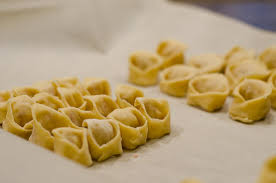
The best part– when we ate them I was instantly transported (in Proustian fashion) back to my childhood– so I knew it was the “right” recipe. My recipe was from a Saveur article by Biba Caggiano, a well-known northern Italian chef with several cookbooks (available through the MVLC catalog ). I always respected my nonna, but now I really respect her. She churned out hundreds of these yummies so efficiently, it never occurred to me how much work went into them.
Looking at the notes from our meeting, I realized that three people made pancake-related items, from three different cultures. One person tried making crepes for the first time, and was pleasantly surprised how simple they were, and how delicious when filled. This French classic is infinitely adapatable, and unfilled crepes can be frozen for quick future meals. And you don’t need a fancy crepe pan; a plain old nonstick skillet worked great!
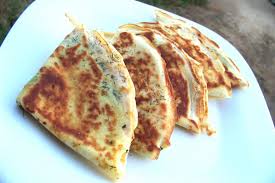
Another member tried making scallion pancakes and had the opposite experience: they were more difficult and took longer to make than she’d expected. It was hard to get the dough to come together; overall it took her 2 1/2 hours to make 8 pancakes! They were tasty, though, and made a nice lunch. Finally, one person tried making whole-wheat pancakes from a Cook’s Illustrated recipe. She was pleasantly surprised to find that they were delicious, and didn’t taste like “cardboard”, or have the consistency of hockey pucks. They were so good, she said you could eat them plain. Sounds like a keeper!
One participant decided to try a recipe that used a homemade salad dressing in two ways in the same dish. You make a honey salad dressing and use part of it as a marinade for chicken. The rest is used for dressing a salad made with the cooked chicken. This recipe is from the show Sarah Moulton’s Weeknight Meals: http://saramoulton.com/2015/01/salad-dressing-chicken. Not too time consuming, and a creative use of ingredients. Another member tried risotto, which has a reputation of being difficult and tedious. It turned out to be neither, but it is one of those dishes that requires your undivided attention with frequent stirring. This recipe was made with chicken stock, wine, and Parmesan cheese. Extra-starchy Arborio rice is necessary for this traditional dish, and though it’s certainly available, not everyone carries it. The risotto was creamy and flavorful, a good pick for wintertime cooking.
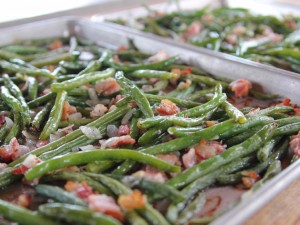
One member’s challenge was to find a vegetable recipe that her husband would like; and the answer turned out to be (unsurprisingly)– bacon! She found a recipe for roasted green beans with pancetta that was absolutely delicious. Others commented that the same strategy (pork fat + oven roasting) works well with Brussels sprouts and asparagus. Heck, it probably works for almost anything!
On the baking side of things, one person decided to try making bread, which ordinarily she would avoid. She tried a no-knead peasant-style loaf that rose and was baked in a Pyrex casserole. The bread was “good” and had a nice chewy texture. She also tried a similar recipe that featured an extended refrigerator rise. That method seemed to produce a better crust. As with many other things we tried this month, the timing had to be taken into account; you had to plan for when the rise would be complete, though the cold rise in the fridge gave you more leeway. It’s so much easier now to find high-quality bread that unless you are a devoted baker, you probably won’t need or want to make bread on a regular basis. Though it’s nice to know you could!
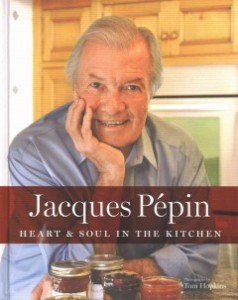
Another member made gougeres from a Jacques Pepin recipe. These savory, cheesy puffs are great as appetizers or with soup. They look a lot more difficult to make than they really are, which always makes for a successful project! Now she is looking forward to trying some recipes from his most recent cookbook.
Thanks to everyone who stepped up to the plate (!) this month! Undoubtedly there will be more cooking challenges in the future.
Our next meeting on Friday, March 25 will feature two titles with a pasta theme: Everyday Pasta by Giada DeLaurentiis, and/or Pasta Modern by Francine Segan. Copies are available at the main desk.
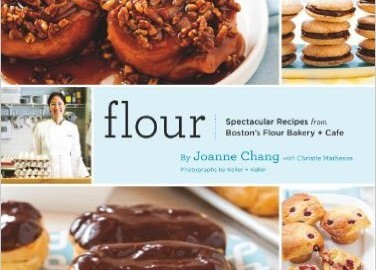
Bibliobites in December: Whole Lotta Bakin’ Goin’ On
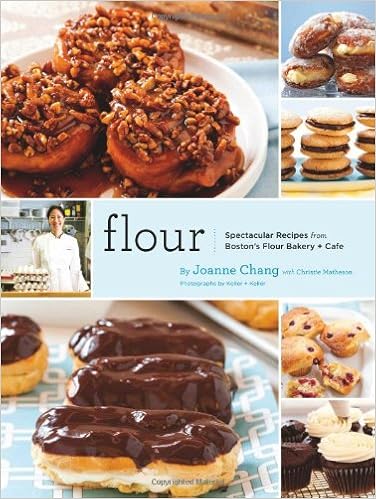 Flour, butter, sugar, eggs: with these oh-so-familiar ingredients a baker can create almost limitless combinations. Many baked goods are classics that have been popular for centuries (think croissants); while others, of more recent vintage, are equally beloved (think chocolate chip cookies).
Flour, butter, sugar, eggs: with these oh-so-familiar ingredients a baker can create almost limitless combinations. Many baked goods are classics that have been popular for centuries (think croissants); while others, of more recent vintage, are equally beloved (think chocolate chip cookies).
This month we had plenty of fun baking up a wide variety of treats from Joanne Chang’s Flour: Spectacular Recipes from Boston’s Flour Bakery & Cafe. Chang, a homegrown success story with four (soon to be five) bakeries in the Boston area, provides recipes for many of her iconic sweets, such as sticky buns and homemade pop-tarts. If you’re feeling a bit more ambitious, you can try croissants, brioche, or eclairs.
Almost all (more on that later!) the recipes tried were deemed successful. Group members enjoyed making (and eating) the morning muffins, apple snacking cake, vegan chocolate cake, lemon poppy seed cake, banana bread, granola bars, scones, homemade pop-tarts, chunky Lola cookies, pumpkin pie, and country sourdough bread. As always, no one minced words in expressing their opinions. The pop-tarts were a bit too sweet; the bread had a too-chewy crust; and some recipes were more complicated than they needed to be. Many thought the serving sizes were overly large, though we recognized that this is the way a bakery usually portions (for instance) cookies; and it’s easy enough to adjust to suit yourself. We loved Chang’s tip for eating a frosted cupcake: slice horizontally, then put the bottom half on the frosted top to make an easy-to-eat cupcake sandwich.
This book is quite extensive, and if you visit one of the bakeries it’s fun to see items in the case that you’ve read about and perhaps tried to make. Chang does her best to demystify even the most complex of treats and make them accessible to the home baker. For example, she devotes four pages of text to the making of croissants. Her explanations are precise and detailed; but let’s just say that there’s something to be said for training and years of practice.
My novice attempt at croissant-making, despite several careful readings of the recipe, produced buttery rolls which, while certainly edible, could not really be called croissants. They were decidedly un-flaky. Though I blame my lack of skill more than anything else, I did have one quibble with this recipe. Chang is quite specific in most of her instructions, but when it comes to proofing the dough, she says only to put it in a “warm” place. What exactly does that mean? If you bake bread, a warm place for rising usually means 80 degrees. However if you proof your croissants at that temperature, the butter in the dough melts. . . . .guess how I know this? And as the butter melts, you lose all the layers that contribute to flakiness. So I’m wondering if by “warm” Chang meant room temperature– but I was puzzled that the exact temperature wasn’t specified. However it was a fun, if time-consuming experiment, and I will certainly try again. In the meantime I have some slightly odd-looking rolls in my freezer that make great toast, and are good for sandwiches, too. So not a total loss by any means!
As for the book itself, everyone enjoyed the beautiful photographs and Chang’s personal anecdotes. Her stories really made her personality come through the pages; as one member remarked, “She would make a great neighbor!” Some felt the recipes were too wordy if you had baking experience; others found the recipes less inspiring than they had anticipated. Most in the group were keen to visit one of the bakeries but this field trip will most likely be put off until spring. Coincidentally, there was a profile of Chang in the Boston Globe magazine the Sunday before our meeting. Much of the information in the article was also contained in the book, but it was fun to read anyhow.
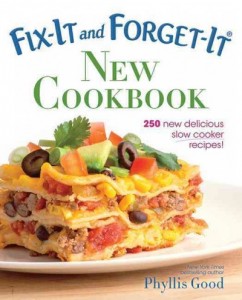 Our next meeting will be January 29th at 11 AM. We will focus on comfort food that can be prepared ahead and be using the Fix-it and Forget-it New Cookbook by Phyllis Good.
Our next meeting will be January 29th at 11 AM. We will focus on comfort food that can be prepared ahead and be using the Fix-it and Forget-it New Cookbook by Phyllis Good.
Happy cooking!
Turkey Treason
This Thanksgiving, I will once again commit a most treasonous act, a vile deed that strikes at the very heart of one of our most sacred holiday traditions. I confess: I do not bring my holiday turkey to the table in all its glorious goldenness, proud on a platter. I do not, and cannot, do this because…..gulp…..I cut up my turkey before I roast it! But before you curl your lip in disdain, before you assume that I carelessly flout tradition, and before you call the Turkey Police, hear me out.
About ten years ago, several family members, along with myself, decided to run or walk the annual Feaster Five Thanksgiving Day Road Race in Andover, MA (shameless plug: this is an awesome event that raises tons of money for several Merrimack Valley social service agencies, and you get a free apple pie for participating!). This poses some logistical problems for the head chef (that would be me). See, the race starts at 8:30 AM; but by the time we’re all done and get back home again, it’s almost 11 AM. So you do the math: put turkey in oven at 7:15 AM, as we’re leaving for the race; or at 11 AM after we arrive back home. One way involves an unsupervised bird ready well before noon, and the other a turkey ready at an awkward midafternoon sort of teatime. Now I know what you’re thinking—why not wait and eat our turkey dinner at, well, dinnertime? Because, as everyone knows, all holidays must involve the preferences of one’s family members, no matter how strange or inconvenient; and everyone wants to eat lunchtime-ish. This gives us all plenty of time to digest our gargantuan meal while falling asleep in front of football games and still potentially have an appetite for a turkey sandwich in the evening.
So there you have it, a turkey conundrum. Not only must all sides be prepped and ready to go by Thursday, I also have had to figure out a way to speed up my turkey roasting so that we could eat at our preferred time. Enter my heretical idea. The first year I tried this I honestly felt terrible hacking up my turkey—it just seemed like I was destroying the very essence of Thanksgiving. OK, so that’s a bit overblown, but I did feel weird about it. And cutting up a turkey, I discovered, isn’t for sissies! You have to wrestle with this cold, slippery, ungainly bird; the knife never seems to be sharp enough; and you have to intimately understand the anatomy of a turkey in order not to make a total mess of things. But I have persevered because the payoff is a perfectly roasted turkey in 1 ½ hours! Yes, even a 20-pounder! As an added bonus, I can take out parts as they finish roasting, so no more dried-out white meat. I’ve even grilled the turkey a couple of times, when the weather was favorable. If you’re a stuffing person, you lay all the stuffing in the roasting pan, position your turkey parts atop, and put it in the oven. Easy-peasy! Not to mention all the fossil-fuel energy I save, and being able to rotate other items through the oven as needed. Carving is simplified, too. Perhaps some of the romance is gone, but I really don’t miss wrestling with a hot, slippery, ungainly bird that I can only pretend to elegantly dissect for serving.
So, turkey lovers everywhere, please don’t judge me! If you’re feeling adventurous and nonconformist, try a little turkey treason with your sweet potatoes and cranberries this year. Just don’t tell anyone it was my idea.
Favorite Thanksgiving Recipes
For our October meeting, we had asked group members to bring in a favorite Thanksgiving recipe. We hope you enjoy discovering something new to enjoy on this traditional holiday. Thank you to everyone who contributed!
Broccoli Casserole: http://allrecipes.com/recipe/164998/rachs-broccoli-casserole/
Cornbread Stuffing with Andouille Sausage: http://www.epicurious.com/recipes/food/views/andouille-sausage-and-corn-bread-stuffing-102481
Roasted Cipollini Onions: http://www.myrecipes.com/recipe/roasted-cipollini-onions
Classic Cranberry-Nut Bread: http://www.oceanspray.com/Recipes/Corporate/Breads-Muffins/Classic-Cranberry-Nut-Bread.aspx
Southern Corn Bread Dressing Squares: http://www.myrecipes.com/recipe/southern-corn-bread-dressing-squares
Cranberry Sauce with Dried Cherries and Cloves: http://www.epicurious.com/recipes/food/views/cranberry-sauce-with-dried-cherries-and-cloves-15656
Pumpkin Cheesecake with Gingersnap Crust: http://www.tastebook.com/recipes/509670-Pumpkin-Cheesecake-with-Gingersnap-Crust
Pumpkin Cheesecake Squares: http://www.wilsonfarm.com/v2.0/recipes/catalog/winter-squash-or-pumpkin-cheesecake-squares.php
Really Good Pumpkin Pie
2 cups pumpkin puree (or 2 1/2 cups “real” pumpkin)
2/3 cup brown sugar
1/3 cup white sugar
1 T. flour
1/2 t. salt
1 t. cinnamon
1/2 t. nutmeg
1/2 t. ginger
1/4 t allspice
pinch black pepper
1 cup light cream
1/3 cup milk (can leave out if you use the more liquidy “real” pumpkin)
2 eggs, beaten
1 t. vanilla
1 partially baked 9 or 10 inch pie shell
Preheat oven to 400F.
In large bowl mix all ingredients with whisk until smooth (you can also use a mixer which will make the filling lighter and fluffier). Pour into the pie shell and bake 45-55 minutes until set but still a bit wobbly in the center. Cool on rack.
“Serve with fresh whipped cream, or, as my cousin calls it, ‘homemade cool whip.'”
Caponata from Principe di Corleone, Sicilia (try it if you know what’s good for you….)
2 white or yellow onions, chopped
7 oz. large green Sicilian olives, pitted
7 oz capers
1/2 bunch celery, chopped
1 1/4 cups white vinegar
3/4 cup sugar
4 eggplants, cut in chunks
4 cups tomato sauce (“Barilla is good; make sure it’s the one in a jar”)
Cook onions over low heat in skillet coated with olive oil until onions are soft and slightly brown. Add capers and olives.
Blanch celery for 5 minutes in boiling water. It should be cooked but still crunchy. Add to pan with onions.
Add the sauce to the pan; add half of the sugar and half of the vinegar and simmer for 20 min., then add the rest of the sugar and vinegar and simmer for 5 more minutes.
In another large skillet, heat a neutral-flavored oil. Add eggplant chunks and saute until tender but not mushy. Add to the sauce in the other pan, mix gently but thoroughly. Garnish with fresh basil and serve warm or at room temperature with good Sicilian bread. Maybe some wine, too!
Bibliobites in October: Make it Ahead….or Not?

For anyone who’s ever stared into their refrigerator at 6 PM after a long day at work and wondered what on earth they would eat for dinner, the appeal of planning ahead is undeniable. This book promises to provide strategies that will enable us to quickly produce a from-scratch meal at the end of the day. But reviews for this title were mixed, and many questioned whether the approaches presented actually did save time.
As far as the book’s format, several members liked the “tips” section at the front, which provided general information on storing and freezing foods, as well as strategies for prep and portioning. Everyone enjoyed the layout and the many photographs. This book is arranged according to the method of making ahead, rather than by the main ingredient, but most people felt this wasn’t a problem; and the index seemed comprehensive enough if you wanted to search by a specific item. Many commented on the overall wordiness of the headnotes in particular– but this is a hallmark of Cook’s Illustrated. Some love this feature; others can’t stand it. Some recipes seemed overly involved for what they were (one example is the chicken Marsala) and/or had needlessly complicated instructions. Some recipes would have been simpler if they were just made then and there, instead of trying to “do ahead.” But most people came away with a good idea or two for streamlining their meal prep, as well as a few new recipes– even if they never again made them ahead of time! One favorite time-saver: do as much prep as possible on the day you shop– chop onions, separate broccoli into florets, cut up chicken, etc. Then when it’s time to cook, you’re all ready to turn on the stove. And fewer knives and cutting boards to wash!
Group members tried lots of different recipes from this book. One reader tried the teriyaki steak tips, but found them “boring.” She also tried the baked ziti with Italian sausage and loved it, though another person found this same dish “greasy and bland.” Potato-leek soup was “better than expected– and very simple to make.” Chickpea patties were also easy and good, with a delicious sauce. Tortellini salad was deemed a winner, as was the panko-crusted cod, the chicken fingers (“awesome!”), and the beef and broccoli stir-fry. Others that proved less popular included the vegetarian black bean chili (the large amount of chili powder overwhelmed the dish), the beef tamale pie (“tasty but logistically difficult”), and the slow cooker turkey soup (it slow cooked for 10 hours and then you needed an additional hour to add and cook rice), which was just “OK.”
In general, if your work time is flexible or you get home on the earlier side, you may not need to do as much planning ahead as this book endorses; but if you are usually out all day every day until the dinner hour, you may find that some or all of the strategies in this title are helpful. It’s always good to have some new meal prep tricks up your sleeve!
Bibliobites in September: Behind the Swinging Doors
After taking the summer off, we reconvened on a sunny September day to discuss Michael Gibney’s action-packed, adrenaline-fueled memoir describing 24 hours in the kitchen of an upscale Manhattan restaurant. Gibney’s account is both affectionate and unsparing, and he creates a vivid sense of place, that feeling that “you are there.” As always, there were plenty of opinions among our readers.
Most of us admired Gibney’s writing style and his ability to draw you into the action with his descriptions. Even those who weren’t crazy about the book appreciated his skills as a writer; one reader was so immersed she felt as though she was one of the tattooed, hung-over, exhausted cooks. Gibney expertly depicted the rough and tumble nature of the restaurant kitchen and its cast of idiosyncratic characters. We thought he did a terrific job of building tension as the day wore on and dinner service approached; we could feel the stress of being on the edge of disaster, and the frustration when something went wrong.
Some readers didn’t enjoy the descriptions of the food at the restaurant depicted– the food was a little too esoteric to be appealing. The unusual ingredients and complex preparations distanced the home cook from the kitchen experience. Some thought that the bare bones menu descriptions often used in high-end restaurants were frustrating as you were left wondering how the dishes were being prepared, while others maintained that this surprise was part of the fun. Everyone appreciated the glossary of cooking terms in the back of the book– a fascinating mix of slang and classic French cooking phrases!
Some might have thought that the kitchen environment depicted was an exaggeration, but a member who worked as a waitress for 25 years confirmed that it wasn’t. The restaurant where she worked had two chefs who were always fighting, and no one wanted to try to break it up because a chef with a temper and a sharp knife is a dangerous combination!
A few readers wished that the book had included a few recipes to try; but alas, the chef-memoir genre doesn’t always include this. If you like to read about chefs and their personal and culinary journeys, try one of the following:
Blood, Bones, and Butter by Gabrielle Hamilton
The Sweet Life in Paris by David Lebovitz (this one does have recipes!)
Lunch in Paris and its sequel Picnic in Provence by Elizabeth Bard (also with recipes)
Heat by Bill Buford
Life, on the Line by Grant Achatz
My Life in France by Julia Child
There are many, many others; if you have a favorite title in this genre please let us know and we’ll add it to the list.





